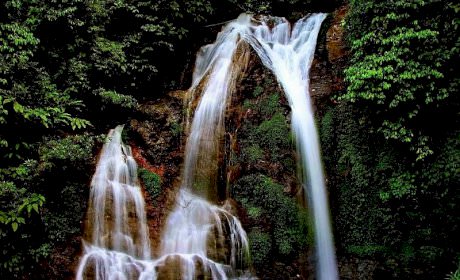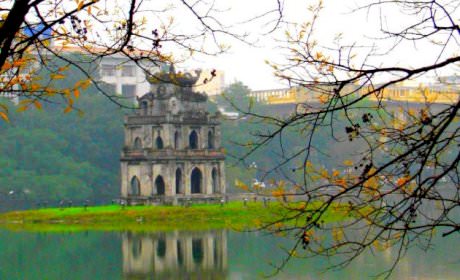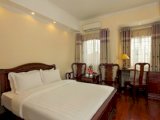Experience visiting Thay Pagoda - Hanoi
Thay Pagoda is located at the foot of Sai Son mountain, also known as Thay mountain, Phat Tich mountain, in Sai Son commune, Quoc Oai district where is about 20km away from the center of Hanoi city. In the space of majestic mountains and hills, Thay Pagoda looks peaceful and quiet. This pagoda is associated with Zen master Tu Dao Hanh, who has great merit in teaching and curing people and founded the water puppetry.
From the city center, it only takes about 30 minutes by motorbike to reach Thay Pagoda.

'
'
How to move to Thay Pagoda
Going by private vehicles
-
By car
If you take a car, you use the route Thang Long Boulevard (CT08) to the Sai Son intersection, then turn out of the highway, go to the right for about 3km, you will see the guiding information to enter the car parking area.
-
By motorcycle
If traveling by motorbike, you go along the road to gather Thang Long Boulevard (motorbikes are not allowed on Thang Long Boulevard, please note not to enter), the distance from the intersection of Big C - Tran Duy Hung to the turn to Thay Pagoda is about 15km.
'
Going by public transport
If you want to go to Thay Pagoda by public transport, you can use the bus. Currently, from the center of Hanoi, you can go to Thay Pagoda by bus CNG01 with the route My Dinh Bus Station - Son Tay Bus Station, the car will stop at the entrance of the Thay Pagoda.
'
'
The best time for visiting Thay Pagoda?
The festival of Thay Pagoda takes place from 5-7 March of the lunar calendar (in which the main festival is on March 7). If you want to experience and learn about the unique cultural features of this festival, you can go to Thay Pagoda at the festival time, but the number of tourists will be extremely crowded.
If you simply want to go sightseeing at Thay Pagoda, you can go at the other time when the weather is cool and the tourists are not crowded, it will be more comfortable.
The time after Tet (but not yet to the main festival) is the time most people do spring traveling because the air is still quite cool, not yet entering the sultry summer.
The beginning of March is the season when the rice flowers bloom at Thay Pagoda, at this time the rice trees around the temple attract a lot of photographers to come for photos. If you plan to go at this time, you should go on a weekday.
Around September-October, Hanoi is in the autumn, so the weather is also very pleasant.
'
'
Attractions at Thay Pagoda
''
Thay pagoda
The road leading up to Thay mountain from the ticket sales point is quite easy to go, only a few quite steep sections, but be certainly nothing when you are immersed in the fresh and spacious atmosphere. Along the way, there are many spots with beautiful views. It takes about 15 minutes to climb the mountain, you will reach the gate of the temple.
Thay Pagoda is an ancient temple, with a curved roof, built quite spaciously with a unique architectural style of Tam script, including Lower Pagoda, Middle Pagoda and Upper Pagoda, they are parallel to each other. Bounding the pagoda is an open space with Long Tri Lake (Long Tri: dragon pond) with clear blue water, blooming red rice flowers, a water house that is a place for water puppetry.

On the other side of the temple are two small bridges called Nhat Nguyet Tien Kieu (Sun and Moon bridge). On the right is Nhat Tien Kieu (Sun bridge) looking at the Tam Phu temple, and on the left is Nguyet Tien Kieu (Moon bridge) connecting with the road to the mountain.

'
Cao Pagoda
Up in the middle of Thay mountain is Cao Pagoda, where Zen master Tu Dao Hanh started his spiritual path. Behind the pagoda is Phat Tich cave, which is said to be the place where Zen master Tu Dao Hanh escaped from his body to be reincarnated as King Ly Than Tong, that's why it is also called Thanh Hoa cave (the sanctified cave)
.
Going to the back of mountain is Cac Co cave - a famous mysterious cave because of its mysterious legend. According to folklore, this is the place where 3,600 Lu family troops are buried alive. Currently, at the end of the cave there is an altar to the General and a bone tank built by the pagoda and the local people. The cave is wide and deep, the road is slippery, so it is easy to slip, you have to find each step and hold on to each other while walking.

'
Flea market
Continuing the journey, you will reach Flea market - the highest place of Thay mountain. Standing here, you will be able to see the vast scenery, watching the green fields.

'
The complex of temples around
- Thuong Temple (Van Xuong Temple): Located on the other side of the mountain, above Boi Am Pagoda, next to But Moc cave, unique and interesting, followed by the murky Bo cave, Gio cave where the wind blows very strongly.
- One Roof Pagoda (Boi Am temple): Located at the foot of the mountain, there is a back door to go up the mountain, including the Front and Upper Palace, the Bell tower and Uncle Ho's memorial house (be the clan ancestral house of Boi Am pagoda in the past). Here, Uncle Ho lived and worked from February 3 to March 2, 1947.
- Long Dau Pagoda: located right next to Long Tri Lake, opposite the main gate of Thay Pagoda
- Sai Khe Pagoda (Hoa Phat Temple): a temple was built quite early at the foot of Hoa Son mountain, there are 51 round statues with the Cuu Long court, many beautiful statues such as Dai The Chi Bodhisattva, Avalokitesvara Bodhisattva…
- Quan Thanh Temple: Located at the foot of Ho Son mountain, about 1km to the southeast of Thay Pagoda
'
'
A few notes when traveling to Thay Pagoda
- Entrance tickets to Thay Pagoda is currently at 10,000 vnd/person
- You can follow the 421B road that closes to the gate to reduce the walking distance.
- Although you have to climb the mountain, but the total time it takes to go up and down is only about 2 hours, you have gone to most of the places in Thay pagoda.
- Dress politely and neatly. During the trip, there will be many quite slippery climbing roads, you should wear sports shoes with good grip or something that is useful for climbing.
- Bring some snacks and drinks to use along the way.
- When using the services, or if someone suggests helping you to arrange the ceremony, remember to ask carefully in advance whether to pay the fee or not, what the price is to avoid being charged too much money for them (especially during the festive season).
'
'
Source: collected










